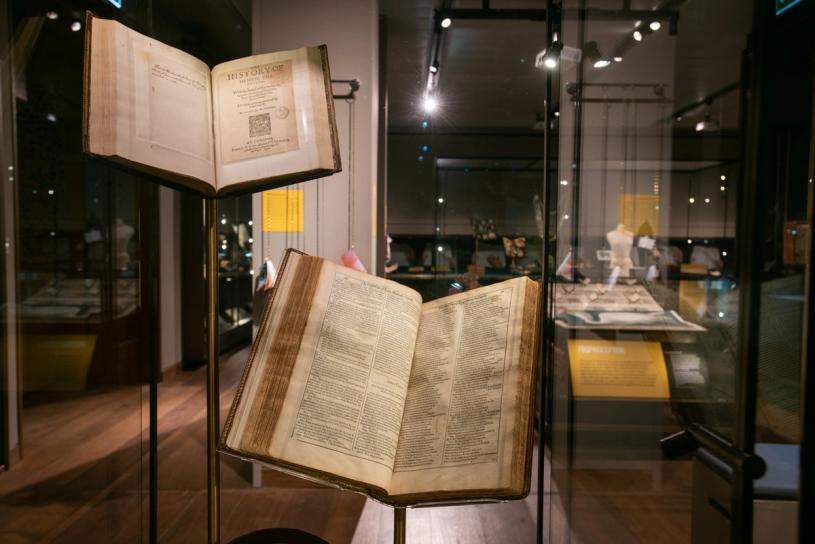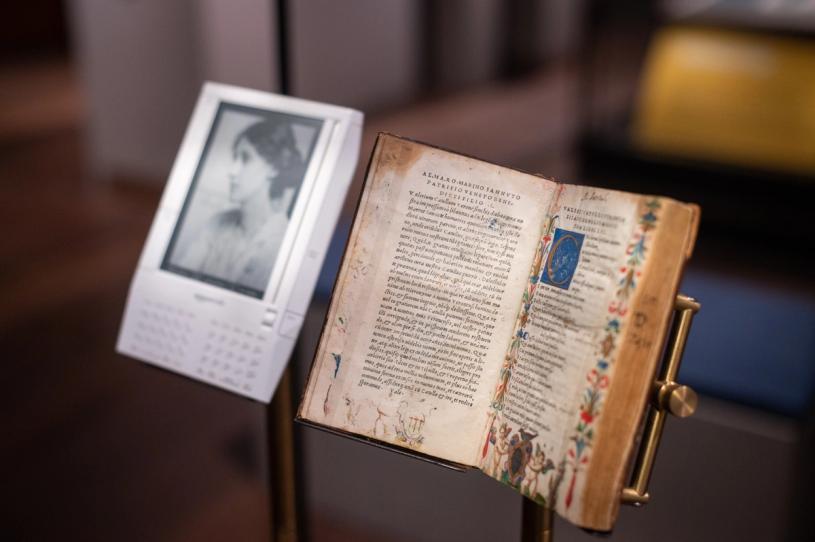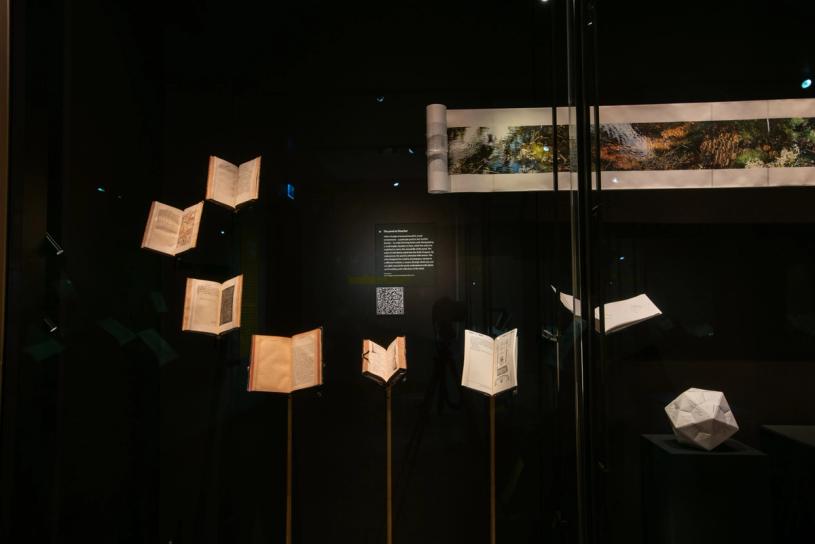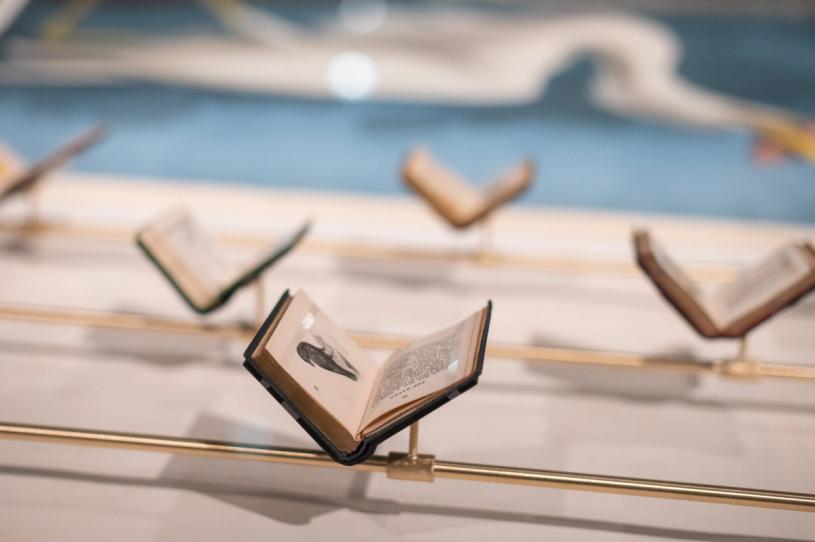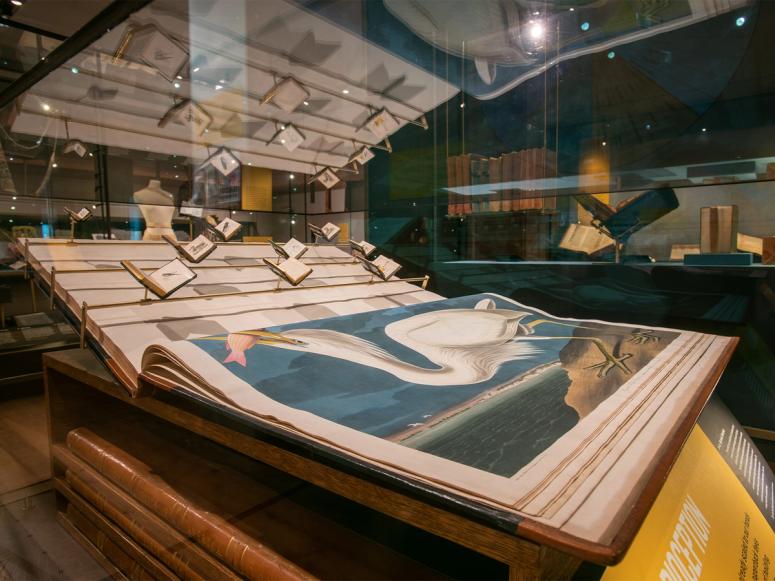
In 1940, Dorothy Kunhardt published a book that would forever change the way young children read. Pat the Bunny, an interactive book full of activities such as touching the sandpaper of “Daddy’s scratchy face,” playing peekaboo with a piece of cloth, or gazing in a mirror, imbued the act of reading with a new form of sensory engagement. Today, “touch and feel” books for babies and children are almost required reading—their cellophane stuffing produces a satisfying, A.S.M.R.-level crunching sound, while the use of faux rabbit fur or horse hair offers an exhilarating tactile experience. As we age and our reading comprehension sharpens, the books we pick up prioritize a single sense—sight—their stories seemingly locked away in lines of text.
An exhibition at the Bodleian Libraries at the University of Oxford, titled “Sensational Books” (on view through December 4), delves into the many roles that books play in our lives across the senses. Co-curated by Kathryn Rudy, professor of art history at the University of St. Andrews, and Emma Smith, professor of Shakespeare studies at the University of Oxford, the exhibition opened to the public in May after two years of delays due to the pandemic. Celebrating the physical book in all its exquisite and unusual forms, “Sensational Books” draws from the centuries-old library’s illustrious collections to understand more deeply what books can tell us beyond the words and images they contain.

As visitors enter the gallery in the Bodleian’s Weston Library, they are greeted with a vitrine asking “Kindle or Codex?” that acknowledges the shifting role of books in our lives due to the increasing presence of digital and audio reading. Though these more recent advents are more efficient for delivering content, their streamlined simplicity dissolves a world of sensory inputs once associated with reading. “There’s the weight of the book, the sense of the paper, the feel of the cover, the smell of it, the sound it makes when pages turn,” Smith says. “We tried to start with that, to remind people that they are conscious of using different senses when they read books.”
One interactive exhibit invites visitors to encounter famed literary objects and refine their olfactory palate through a collection of perfume atomizers containing scents distilled from books including Shakespeare’s 1623 First Folio and one of the Bodleian’s greatest treasures: a 1217 copy of Magna Carta. A scent distilled from a collection of 17th- and 18th-century books, usually housed on the timber shelves of the Bodleian’s oldest reading room offers a warm, sweet aroma characterized by meadow hay, pipe tobacco, and cedarwood. The prized Magna Carta, by contrast, boasts “an aromatic mix of moist wheat bread and beach sand,” Smith says.
The smokey, spicy aroma extracted from an Ethiopian gospel bound in kid leather demonstrates a book’s rare ability to absorb and retain the scents of its surrounding environment for decades. Smith reflects upon a project when, years earlier, the Bodleian worked with members of local Ethiopian and Eritrean communities to co-curate a selection of manuscripts and icons produced in the Ge’ez language. In the process of reviewing materials for the display, a group of co-curators of Eritrean descent opened the kid-bound gospel and concurred that the scent contained within its pages had the aroma of “home.”
The scents from these celebrated works on paper were developed in collaboration with the Oxford-based Institute for Digital Archaeology (IDA), a venture that promotes the development and use of digital imaging techniques in conservation. Using noninvasive techniques specially developed by the IDA, technicians placed objects in sealed glass containers and used circulated air to capture the compounds that carry each book’s scent. Olfactory specialists then bottled the scents to be experienced alongside one another, with the aid of an informative wheel chart of aromatic notes created in the spirit of those used for cheese or wine tasting. “It is indeed a bit like wine tasting,” Smith says. “Once you’ve got the vocabulary, you can begin to differentiate the smells.”
Through a series of objects that employ books as an artistic medium, “Sensational Books” also investigates the relationship between bound pages and our taste buds. In her piece “Farmer’s Market” (2019), artist Dizzy Pragnell examines the materiality of books’ early antecedents, centering upon the layering of natural papyrus fiber, a technique used in ancient Egypt and other Mediterranean cultures to create writing materials before the introduction of paper. Pragnell’s technique reimagines this history in the form of five books whose pages are composed of thinly sliced dried fruit and vegetables—materials that tempt the viewer’s appetite and satisfy the senses through exquisite color and pattern.
Another particularly magnetic piece on display comes from New York–based artist, designer, and publisher Ben Denzer. No stranger to the book as an art form—his credits include designing book covers for Penguin Art Group and running the Instagram account @ice_cream_books, which counts both Bella Hadid and art critic Hal Foster among its fans—Denzer is behind 20 Slices (2018), a hard cover book whose pages are substituted by shelf-stable, plastic-wrapped slices of American cheese. The book rotates slowly—perhaps infinitely, one might wonder—in a mini fridge, its pages an imperishable material offering a point of inquiry about art books and preservation.
Several works in the exhibition examine the sense of touch in connection with reading, using books that have collided with hands... and lips. A German 16th-century missal printed partly on silk includes in its pages a pasted-in “osculation plaque” for a priest to physically kiss the book in an act of religious devotion. Another ecclesiastical artifact, designed as an aid for repentant 17th-century sinners, is “Nouvelle invention d’une excellente methode, pour ... une bonne confession.” Composed of hundreds of perforated tabs, each bearing a different transgression, this “catalog of immorality” permitted users to conveniently tear out a prewritten confession and present it to their priest rather than speak the words themselves.
John James Audubon’s colossal illustrated The Birds of America (1827–38) demonstrates the sense of proprioception—the body’s ability to sense movement, action, and location, often described as the “sixth sense.” The brown leather-bound book is just under a meter and half in length, or about the wingspan of a large seagull, as the audio guide appropriately notes, and requires two people to open it and turn its blanket-like pages. “We’re focusing attention on the physical work we’re always doing with books,” Smith says. “It’s how hard we need to hold them open, how tight the binding is. It explores how books are bits of paper and engineering.” Contrasted with a group of smaller volumes, one can begin to imagine the incongruity in the physical experience of handling and reading each one.
As visitors approach the section on sound and hearing, they are greeted by an impressive 14th-century book of psalms from the Church of St. Lawrence in Trau, its pages rippled and warped by the moisture exhaled by singing chorus members of centuries past. Andy Warhol’s Index (1967), a tongue-in-cheek “children’s book for hipsters,” serves as a multi-sensory encounter personified by a pop-up castle, a sheet of LSD stamps, and a 45-rpm flexi-disc that plays a previously unrecorded song by Nico and the Velvet Underground.
Further sonic studies in the exhibition include a series of sound-based works by artists Helen Frosi, Pale Blue Dot Collective’s Louise Beer and John Hooper, and Amy Sterly and Andrew Albin. Pale Blue Dot Collective’s “Audioscripts,” a piece co-commissioned for the exhibition with Fusion Arts in Oxford, looks at the auditory output of our physical interactions with books. Recordings include the sound of pages turning, books being arranged on shelves, and hands moving across textured covers against a backdrop of sounds documented from nature in three audio compositions. “We wanted a lot of noise in the exhibition room—some of which was specifically of books, and some which was creatively spinning off of that,” Smith says.
“Sensational Books” also explores sound as a means to enrich and provide access to the art-viewing experience. Exhibition curators partnered with VocalEyes, whose mission is to foster opportunities for blind and visually impaired people to enjoy art and heritage, to create an audio described highlights tour. The guide—which was developed with all viewers in mind—connects visitors intimately with the objects on display using lush descriptions of how each book may look, sound, feel, and smell.
One idea that began to materialize in the early stages of producing the exhibition is the reciprocal nature of reading physical books. As books shape our thoughts and experiences, we, too, imbue them with traces of ourselves, from handwritten annotations to smudges that show signs of frequent use. In this way, the story of the material books is a story of human nature—our activities, our relationships, and our hopes for the future.
Keep reading
How or when do we talk about the books that move us? Perhaps at a dinner party. With a bookstore clerk or librarian. May
What gives a physical movement meaning? There are myriad answers: context, shape, intention. For internationally renowneDimitri Chamblas, there’s another, primary answer: speed. “If I go to shake your hand, you would understand because of the movement, but
With everything he does, the Los Angeles–based designer and creative director Willo Perron always considers the macro an
Designed in 1972, at a time when a luxury watch made of steel was still a radical concept, Audemars Piguet’s nautical-inGQ editor Bill Prince, author of the new book Royal Oak: From Iconoclast to Icon (Assouline), coming out October 12. “It’s one of those works of culture that has managed to cut through time, in the sebigger than the era.”
Hiring a world-class architecture firm to design a tiny temporary retail space may seem an extravagant choice, but given
In co-founding Slow Factory in 2012—a Brooklyn-based nonprofit dedicated to advocating for slow fashion and advancing climate justice and social eqthe latest guest on our Time Sensitive podcast—created a platform to further one of her life missions: to replace socially and environmentally harmful and outdated sy
For Janne Saario, a former professional skateboarder turned skate park designer, the best skate parks exist in harmony w
As one of the world’s foremost trend forecasters, Lidewij Edelkoort has advised companies ranging from Coca-Cola to Lacoste on everything from how to communicate with emerging youth archeTrend Union—that forecast market movements two or more years in advance. In the textile industry, her research has been used by fas
The first attempts to create language around matter—at least in the tradition of European philosophy—began with an obserhyle,” or that which receives form or definiteness. The notion of hyle proposes the idea of a universal basic substance from
With the climate crisis a chief concern of worldly citizens, Fortune 500 corporations, the United Nations, and even the U.S. Department of Defense alike, a “made from recycled water bottles” origin story has practically become ubiquitous. Now more than ever shoppersFirst Mile, though, doesn’t see recycled bottles as a marketing ploy; they see them as a tool for empowering consumers to demand m
The organ often shocks by the strength of its scale alone. Few other instruments, after all, can be so large as to necesOrgan Scholarships from Oxford’s Magdalen College in its 560-year history and, shortly thereafter, at age 21, becoming director of music f
A motorcycle, at its most basic, is merely an object: two wheels, an engine, and a seat, on which a rider (if not a kick
Taking on the finest Swiss watchmakers, Japan’s Grand Seiko has risen to the top of the industry with its mix of beautif
Writer Hannah Lewis says she practically fell in love with Japanese botanist Akira Miyawaki when she first read the 2007The Healing Power of Forests, which he co-authored with ecologist Elgene O. Box. The book introduced the Miyawaki method, a reforestation technique Compendium of Scientific and Practical Findings Supporting Eco-Restoration to Address Global Warming, a bi-annual, open-access compilation of scientific studies, industry and government reports, and journalistic investigwrite an article about the approach for The Guardian in 2020, and a just-released book of her own: Mini-Forest Revolution: Using the Miyawaki Method to Rapidly Rewild the World (Chelsea Green Publishing).
For time immemorial gardens have served as spaces for rest, reflection, and communion with the natural world. But in todhas written, “Ultimately, every garden is an ideology.”
“What is the texture of scale? Can a surface be eliminated? Can space expand?” Viewers encounter these and other questioObjects in Sculpture” (through Oct. 10), Minnesota-based designer Jonathan Muecke’s first solo presentation in a major museum. For Muecke, a
Among all the significant seats in the design canon, few are as recognizable as Emeco’s 1006 Navy Chair, which was designed in 1944, in the midst of World War II, for the U.S. Navy. Resourcefully made from
In a city boasting many of the world’s greatest art museums, it’s perhaps easy to overlook the jewel that is the Morgan Library & Museum, which spans more than half a block, between Madison and Park Avenues, in Manhattan's Murray Hill neighborhood. But witmultiyear restoration of the original library building’s exterior finally complete, as well as the just-overhauled Morgan Garden, unveiled la2006 expansion by Pritzker Prize–winning Italian architect Renzo Piano, which integrates the site’s three historic buildings within th
With practically everything they do—or at least with their many time-honored ceremonies and traditions, from yuritsuki gardening to the brewing of gyokuro—the Japanese bring great care. Gift-wrapping is no exception. Taking cues from the island nation’s rich, detail-driven heritage, and celebrating the latter art, theKoyori chose its name. Meaning “twisted paper cords,” Koyori references the primary material of mizuhiki, the decorative paper cords commonly used in Japan to tie paper-wrapped gifts. The metaphor is apt: Koyori’s exquisite Milan Design Week—is the British product and furniture designer Jasper Morrison, who serves as its “brand directing advisor.” Tapped by e
In 1918, Dutch architect and furniture designer Gerrit Rietveld developed the first iteration of his influential Red Blue Chair. A member of the de Stijl art and architecture movement, which espoused the belief that a post-World War I Europe couldDer Aesthet, and to attach it under the seat: “When I sit, I do not want / to sit like my seat-flesh likes / but rather like my seabeyond the point of intersection. By magnifying these oft-hidden details, Rietveld forged a new transparency in design—and spoU-Joints: A Taxonomy of Connections, an independently-published compendium from architect Andrea Caputo and design professor Anniina Koivu, who served as e
For the past 16 years, Rebecca van Bergen has been laying the groundwork for a more equitable, inclusive, and transparenNest, van Bergen has woven together a potent platform for change. Its name is as clever as it is befitting. The notion of buEileen Fisher on things such as production compliance, responsible sourcing, and connecting designers and craftspeople. This is just
One might describe Alcova, an independent design platform that activates forgotten sites in and around Milan during the city’s design week, as a
Last week, the Earth slid between the moon and sun, inciting a heady lunar eclipse that transformed our usual relationshManitoga, a stunning midcentury home turned design center that’s nestled between a granite quarry and a mossy slope in upstate NDesigning Nature” (through November 14). Fittingly, the first piece visitors encounter is the Eclipse Ceiling Lamp, designed by the contFormafantasma in 2016, which casts new, entrancing light on its surroundings.
Nestled in a cozy pocket of Newburgh, in New York’s Hudson Valley, is an architectural gem designed in 1949 by Philip Jograppling with how to address Johnson’s legacy in the aftermath of his fascist views becoming more widely known—the property was purchased and restored by Jiminie Ha,With Projects, and art director Jeremy Parker. Determined to establish the residence as a symbol of inclusivity, the two have reimagiWolfhouse, a community-focused cultural space and incubator with public programming centered around art, architecture, and design
The Spanish designer Alvaro Catalán de Ocón’s repurposed plastic furnishings weren’t just born from a sense of duty. Whirecently deemed an epidemic—he also appreciates the material for what it is: a lightweight, flexible, yet strong substance that can be sculpted intACdO. “The problem is that the price and the value of the material does not match at the moment.”
Squares, with their even proportions and sharp corners, evoke a sense of honest, hard-edged rationality. The shape has dKvadrat, the 54-year-old Danish textile company known for its forward-looking, often vibrant fabrics and artistic collaboration
If you look around your living space, there’s a good chance that all the furniture in it is designed for adult use and cNalata Nalata’s upcoming exhibition, “Starter Chair” (May 14–22), celebrates furniture that was lovingly made on a different scale—one specifically for children.
To speak with self-described “citizen artist” vanessa german about her creative practice is to talk with her about art as a means of revitalization and protection. Particularly for
In the late 1960s, Czech psychotherapist Stanislav Grof concluded, through his research on LSD at John Hopkins Universit
During a recent sort through my recycling—paper-towel tubes, condiment containers, and other receptacles—I noticed that
Growing up on the Italian island of Murano, Luca Nichetto was constantly around people who made things. The grandson of
Stefan Sagmeister is a contemporary polymath. Following his curiosity through many forms, the Austrian-born, New York–baobjects, installations, and participatory artworks throughout his decades-long career. (Sagmeister speaks about some of these projects and others on Ep. 8 of our Time Sensitive podcast, and on Ep.106 of our At a Distance podcast.) While his output, at first glance, might appear to move wildly between subjects, a closer look reveals a consistent i
On average, children grow seven sizes in just their first two years. As a result, parents end up spending an average of $3,000 on clothing—much of which ultimately joins the 17 million tons of clothing that finds its way into landfills every year—before their child reaches the age of 3. Considering these realities, aeronautical engineer Ryan Mario Yasin wondered: with them?
Tactility has been central to Omar Sosa’s creative practice for years. He developed a fondness for making books while working as a graphic designer and art dirApartamento, which has developed a cult following for its content—candid conversations with creative people from a variety of field
For Megumi Shauna Arai, textiles are universal indicators of culture and identity. Like 19th-century crazy quilts or the lively blankets that noren, traditional Japanese fabric dividers that are suspended in windows and doorways (seen in a Manhattan pop-up of Beverly’s Shop last year), and others laid flat, as was one particularly striking piece on a bed at the Eliot Noyes House in New Canaa2020 edition of the art and design fair Object & Thing—that invite viewers to consider the histories and techniques they represent.
From the looks of things, physical retail may well be losing out to e-commerce (and perhaps soon, shopping in the metaverse). But a comeback for brick-and-mortar stores appears to be on the horizon, and if the architects at the Paris-based firm Moinard Bétaill
For several years, artist Dan Colen wasn’t exactly sure how to talk about Sky High Farm (SHF), a nonprofit 40-acre regenerative ecosystem he created in New York’s Hudson Valley that, since its beginnings in Ep. 40 of our Time Sensitive podcast. “And the lightest touch seemed to be through products.” In 2019, he partnered with the international concept shop Dove
Putting on the breaks has long been a challenge for Corvin Lask and Christopher Noerskau. The pair met as teenagers at aSlow, a line of stark, Swiss-made watches with the aim of helping their wearers slow down.
A cone is a many-splendored shape. Both aesthetically pleasing and functional, it can do everything from redirect traffi
The enduring relevance of jewelry in society and culture stems, in part, from its adaptability, but also from its intima
Carole Collet, a professor of Design for Sustainable Futures at Central Saint Martins (C.S.M.) in London, has spent decades studying
Clothing designed to endure such harsh conditions as sub-zero temperatures, damp romps in rainforests, or icy traipses tEp. 69 of our At a Distance podcast.
While fashion brands often design their garments based on fleeting trends, twin brothers and athletes Nick and Steve TidVollebak, with a more certain future in mind: one that involves environmental threats and the continued exploration of space, an
There is something universally comforting—deeply intoxicating, even—about petting a soft, warm coat, deep with pile. MayFuwa Fuwa ( “fuzzy,” in Japanese): “I reach out to touch the fluffy, soft fur, gently run my hand over the broad nape of the neck
2014 may have been the year of the booty, but it took me six cold and less-than-sterile more (plus 2020’s lockdown) to get mine into the warm seat of a Toto Washlet C200, my top pick in this rotund—or rather, well-rounded—assortment of bidet toilet-seat attachments—and love-letter the for
Green thumbs have long extolled the value of raised garden beds for their weed-reducing and water-retaining abilities, nPlanted—a New York–based company that provides resources and materials for cultivating your own food, including seedlings sourc
In recent decades, art has steadily expanded into the digital realm, thanks, in part, to copious new apps, tools, and tuForest Crayons, a series of prism-shaped drawing implements that are made from natural materials and that use wood as their sole sourc
In 2014, Eddie Cohen embarked on a 10-day silent meditation retreat to further his practice of quieting his mind. Sittin
Despite being among the most abundant tree species in Finland, pine has been largely overlooked and underutilized as a fVaarnii seeks to revive the use of pine in furniture making, and with it, forge a new era in Finnish design that celebrates the
While the bonnets and muskets seen in Virginia’s Colonial Williamsburg—the early American settlement turned immersive ouCraft & Forge, a wide-ranging line of spare, everyday accessories for the home that will debut at the end of the month.
Before fast fashion became the norm, children typically learned how to make their own clothes, often from their parents Almaborealis, a line of D.I.Y. sewing kits that teach kids the value of creating garments that last.
A gold dial Titan quartz wristwatch with a worn-out brown leather strap. A 32-caliber Colt pistol. A dekchi, or brass cooking pot for cooking the traditional rice dish biryani. A signed letter from Mother Teresa. An Imperial Bank of India checkbook. These are but five items in the collection ofMuseum of Material Memory, an online repository of objects from across the Indian subcontinent, dating from or before the 1970s, including books,
Those who have come to embrace CBD—short for cannabidiol, a chemical abundant in the cannabis plant that, unlike its sibEpidiolex, to treat rare seizure disorders; the majority of scientific studies on the chemical have been conducted on animals.) T$16 billion by 2025, fueled by users who report relief from afflictions including anxiety, depression, and stress. So it seems only natural
For Lorne M. Buchman, president of Art Center College of Design in Pasadena, California, the creative process rarely conYves Béhar, Paula Scher, and Frank Gehry, as well as companies such as Apple and Tesla, attest to such experiences in Buchman’s neMake to Know: From Spaces of Uncertainty to Creative Discovery (Thames & Hudson), as archetypes that demonstrate the value of embracing the unknown as a way to unleash new ideas.
While producing a line of luxury outerwear, Dutch fashion designer Bas Timmer learned that the homeless father of two ofSheltersuit Foundation as a means of producing the pieces on a larger scale. Since then, the organization has given away more than 12,500 Shel
La Samaritaine, a historic Parisian department store that towers over the banks of the Seine, spent the last 16 years unDior Spa Cheval Blanc—a collaboration between the hotel chain and the French fashion house—promises “happiness in the heart of Paris,” a tall
High-quality woodworking tools are beautifully crafted objects in and of themselves. Traditionally created by artisans,
At a Los Angeles Exhibition, “Almost-Dysfunctional” Japanese Pottery That Conveys the Circle of Life
In Plato’s dialogue Timaeus, the word khôra—the territory just outside the Ancient Greek city center—is used to describe a condition that serves as a womb-like spa
According to a 2016 report by the World Economic Forum, a full garbage truck’s worth of plastic flows into our oceans almost every minute. While e
The ingenuity of the Parentesi lamp, first released by the Italian lighting brand Flos in 1971, is most evident when it’s handled: Slide the nickel-plated
Elyn Zimmerman will never forget the exact moment when, on February 26, 1993, a truck bomb exploded in the World Trade Center’s underg
“Berbere was the first design I did that had the ability to become a new classic,” Gaia Repossi says of her first collection for
“There should be as many clothing repair shops as there are gas stations,” says Satchel B. Moore, founder of the Saint PScience and Kindness. “After all, there are more pairs of pants in the world than there are cars.” Moore started the initiative, which he ru
One of the biggest challenges for any great brand is to evolve and remain relevant while staying true to its roots. JaegReverso timepiece, which celebrates its 90th anniversary this year, is a brilliant example of an accessory that is both immedia
“This is a new world,” says Cyrille Vigneron, president and CEO of Cartier, during a gala dinner he recently hosted on tSixième Sens (“Sixth Sense”), the luxury house’s newest collection. He continues, “High jewelry belongs to the world of sensory stim
The spareness of Scandinavian design is a school of thought—and a way of life—that’s responsible for the popularity of sTekla, the aesthetic approach means creating everyday pieces for the bed and bath that are high-quality and low-fuss, informe
Earlier this month, a stately structure covered in angled white bricks opened its doors in the East Williamsburg area ofAmant Foundation, a nonprofit arts organization that values a slow, focused approach in making and viewing art. (It has a sister locatio
“Sustainability” is stamped on so many products these days—having become corporate America’s go-to buzzword throughout tEp. 103 of our At a Distance podcast; he’s trying to tackle this issue head-on through data and analytics.
The archeologist-turned-goldsmith Loren Teetelli spent more than 100 hours hand-forging a single 22-karat gold cuff for Loren Nicole, in 2016. Jean Prounis is another millennial who’s mastered the time-honored craft of goldsmithing. The New York–based designer begins her pro
“I’m constantly looking for new links between light and color, but my collections always start as a dream,” says Claire Holographique, unveiled this week in Paris during the city’s fall/winter 2021 haute couture fashion shows, is yet another foray onto
Technology, especially when it comes to screen time, can simultaneously induce sensory overload and sensory deprivation.Google’s first retail store, which opened last month on the ground floor of the company’s Manhattan headquarters (just blocks from The Slowdown’s CEp. 11 of our Time Sensitive podcast) toward a singular goal: to create an environment that demonstrates “how humans and technology [can] come together,” as
In his 1982 book Megatrends: Ten New Directions Transforming Our Lives, the late futurist John Naisbitt predicted that people employed by technology companies would crave real-world social c
One year ago, entrepreneur Jaé Joseph and creative director Brianna Wise released a survey that doubled as an applicatioBlack Apothecary Office (BAO): a three-month-long accelerator program designed to help Black- and Latinx-owned beauty and wellness start-ups reBAO Universe, a digital marketplace offering goods such as velvety face oils, silky moisturizers, and hydrating shampoo from some of
“I don’t just look at stones. I need to touch them, and feel the life inside them,” says Lucia Silvestri, who sources geBulgari and serves as its creative director. “There’s sensuality in the energy of gems born in the depths of the earth.” Such v most exquisite pieces designed by the Roman jeweler to date. (Some 200 other items will be added to the collection later
Slow’s headquarters sits within Marina Marina, a sprawling multi-building campus located just outside Berlin’s city center. When it officially opens, next spring, th
When Louis Cartier designed the Tank watch, in 1917, its rectangular dial was a bold departure from the round cases of the era. Inspired by an aerial view of the
Kintsugi, the time-honored Japanese practice of using powdered precious metals to repair broken ceramics, has steadily gained poKintsugi: The Poetic Mend (Bloomsbury). In it, she interviews kintsugi masters, details various techniques, and considers potential grounds for the custom’s development. Here, Kemske discusskintsugi’s origins and why it resonates so strongly with people today.
In 1983, the British fashion designer Margaret Howell made the first of many visits to Japan, where she discovered toolsAffinities: 50 Years of Design, a new short film directed by artist Emily Richardson that celebrates the distinctive work that Howell—now 74 and with Ep. 44 of our Time Sensitive podcast). The film is on view via the brand’s website and, along with a presentation of drawings and artifacts from Howell’s pe
Over the past three decades, multidisciplinary artist Yolande Batteau has traveled the world to study age-old artisanal Callidus Guild. Yet while Batteau investigates materials, she’s simultaneously doing a similar kind of work within herself—an act thatYolande Batteau: Introspective,” on view at New York’s decorative arts gallery Bernd Goeckler through May 28.
Since ancient times, people have looked to the sun, moon, and stars to create a sense of rhythm and order in their livesLittle Lange 1 Moon Phase watch elevates the poetic movement with a copper-flecked, midnight-blue silver dial that shimmers like the night sky, a
Giancarlo Valle, a celebrated New York–based interiors and furniture designer with an artful, worldly eye informed by hiPlateau table lamp, created with self-taught Brooklyn ceramicist Natalie Weinberger, leans into that sensibility with a more craft-centere
The Proustian madeleine cookie is an oft-cited example of how our memories are intertwined with the senses. But just as Worn Stories, the new Netflix docuseries based on artist and writer Emily Spivack’s New York Times–bestselling book.
During a recent stay in her home city of Los Angeles, New York–based stylist Beverly Nguyen (a Vogue alum and the former studio director for Kate Young) was inspired to dream up her latest venture: a pop-up of homewares called Beverly’s, which opened last weekend in downtown Manhattan. The move home, prolonged by the pandemic, wasn’t intended to last mos
Artist Eric Oglander gravitates toward materials that collapse time and space, and holds an unwavering faith in the powetihngs.com, and plans to open a brick-and-mortar shop of the same name in the Ridgewood neighborhood of Queens later this year). IP.E.,” is on view through May 15.
When a loved one passes, the typical death care options are both limited and harmful to the planet. Conventional burial Recompose, an NOR funeral home located in a Seattle suburb and designed by local architectural firm Olson Kundig (whose principalEp. 37 of our Time Sensitive podcast). Last year, two other NOR companies were formed in the region, signaling that the practice isn’t a pipe dream, but a r
For many diners, using “biodegradable” or “compostable” takeout containers is one way of doing their part in protecting don’t break down in a backyard composting bin and require special conditions to degrade. The Canadian company Case has a better solution: a circular system for food receptacles.
Because of its ubiquity, it’s tempting to describe Emeco’s iconic Navy Chair, designed in 1944, as basic. But that would
As the vaccine rollout continues, previously closed galleries and museums have, thankfully, continued to steadily reopenWhen Practice Becomes Form: Carpentry Tools from Japan,” on view through July 11, presents an ode to the tradition of Japanese architecture and handcraft. On display are an atōryō. The collection of beautiful saws, chisels, and planes demonstrate the ingenuity and resourcefulness of Japanese joiner
Masayuki Nishimoto, founder of the Japanese creative agency En One, knew he wanted to develop an experimental culinary space in Tokyo long before he met Ghetto Gastro’s Jon Gray on the st
East Fork imbues traditional clay tableware with a sense of delight, resulting in pieces that are instantly recognizable. The commonth)—while its expansion into the lifestyle realm, with online recipes and carefully culled pantry items, such as black gar Your products often immediately sell out. A few months ago, an article in the New York Post called your passionate fans the “new potheads.” What makes East Fork’s pieces so covetable?
Recent studies attest to what the crafters among us have known for a long time: that the rhythmic, repetitive nature of knitting, crocCelia Pym, working with her hands is more than a stress-relieving pastime—it’s instinctive. She grew up in a family where repairi
Is our obsession with newness an ailment of capitalism? Kintsugi, the traditional Japanese art of mending broken pottery, has been around for more than four centuries—but its philosophkintsukuroi, meaning “golden repair”—sees breakage as a valuable asset that adds to an object’s history. Fragments are pieced back
Textile designer Anni Albers, who was born in Berlin at the turn of the 20th century, brought a modernist touch and expe“In a Slow Manner,” the first presentation at Paris’s Maison du Danemark since it completed an extensive renovation. Opening Feb. 3, the sh
Hand-wringing and hand-washing seem to be defining this time warp of a pandemic. When it comes to the latter, we’re partSlowdown hand-wash set from the New York upstart Dally Goods—not just for its name (which, to be clear, we’re not connected to), but its ethosExperts say fantasy can provide a way through difficult times; if harmless daydreaming can get us through this moment, we’ll happily indulge in a bit of wanderlust where we can find
Technology and industry often get much of the credit for fueling the United States’ development, but for curator, writerCraft: An American History (Bloomsbury), out next week, Adamson shows how skilled laborers shaped the nation, telling remarkable, often surprising
Dental grills might seem like a latter-day invention, but they’re actually anything but. Decorative tooth accessories weRi Serax, whose outrageous embellishments are worn inside the mouths of rap and R&B artists including Jpegmafia, Princess Nokia,
The culture of wellness tends to focus on trends, like meditation hacks or CBD gummies. But a new app devotes itself to Kama turns to leading neuroscientists, psychologists, somatic therapists, and other experts to help us better our bedroom hasaid in an interview with Forbes that she sees the company as a response to a “sex and intimacy recession” that’s happening around the world. “Our body
Wood boxes are something of a national treasure in Japan, where Buddhist monks began tucking stoles, prayer beads, and okiribako—boxes handcrafted from paulownia, a native tree with lightweight, durable, water-resistant timber—into the mainstream. Masuda Kiribako, which has been skillfully producing traditional receptacles since 1929.
Three years ago, French furniture and object designer Noé Duchaufour-Lawrance—whose clients include Baccarat, Bernhardt Made in Situ that champions the traditional crafts, techniques, and materials of the region through objects he designs and makes witsoenga. How did the idea for Made in Situ come about?
Imagine shopping a trove of objects that are at once elegant and ethically made—no post-purchase consumer guilt necessarGoodee, an online marketplace of homewares and clothing that make a positive impact on people and the planet. Founded by Montrundulating Pakurigo baskets handwoven by artisans in Ghana from locally sourced vetiver grass, vegan seaweed soap that cleverly uses coriander seeds and peppercorns as exfoliants, and the sought-after Goodee Hoodie, recently released in three new colors (dusty rose, Egyptian blue, and alabaster) and made from Egyptian cotton by the Kotn. There’s also a handsome German Douglas pine daybed from Danish B Corp Skagerak, topped with Kvadrat upholstery, and a Japanese windmill palm fiber “corner brush” designed to dust the undustable. Feel like decking the halls? Try these multihued Jipi Baubles tree ornaments, handmade from Jipijapa palm tree leaves by Colombian artisans in the Andes. For those on our gift lists, including the

